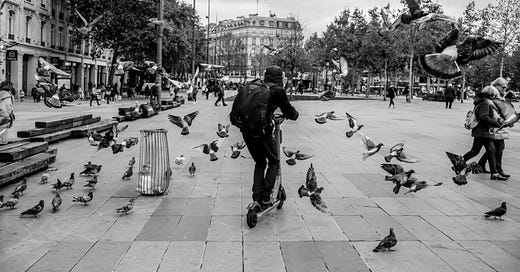What Can Urban Evolution Teach Us?
Plants and animals are evolving due to urban environments, what can this tell us about what's to come?
Hiya!
I was thinking about how our hunter-gatherer ancestors thrived in the ecosystems nature provided them. Their lives revolved around the seasons. They understood the animal kingdom and saw themselves as part of it. Then eventually, our creativity and ingenuity sparked new ideas, such as agriculture and the industrial revolution. Today, we’ve almost completely segregated ourselves by reshaping the natural world to suit us instead of the other way around.
We’ve imagined and brought to life our own ecosystems in the form of governments, culture, corporations, and massive cities. Defaulting to the belief that cities are for people, while Nature belongs outside the limits. However, some scientists beg to differ. Evolutionary biologists point out that cities have become the fastest-growing ecosystems on the planet — and by studying them, experts can test long-standing questions we have about evolution.
Urban Evolution
Humans have been drawn to cities for thousands of years. In the process, we’ve altered, tweaked, spread, and strategized urban design to best serve our needs and desires. Today, over half the global human population lives in cities.
Cities exist in every continent and country (ha! Countries also exist thanks to our imagination!) except for Antarctica, and dramatically change the environment — including animal life. After all, plenty of animals calls our cities home, too.
Now biologists are hoping these animals can answer some questions. Such as, does the environment inspire similar evolutionary characteristics in different species? Or, will different animals within the same species evolve similarly when dealing with the same environmental factors?
Evolutionary ecologist at the University of Toronto, Mississauga, Marc Johnson, told Inverse:
“Many environmental factors are similar across thousands of cities. Things like higher temperatures, pollution, and habitats fragmented by buildings and roads. But cities also differ in age, amount of green space, climate, and more. You can look at these similarities and these differences and start to ask, how can this drive evolution?”
The concept of urban evolution made a tiny wave among scientists in 1955 (which I’ll mention in the next section), but it didn’t grow in popularity until the 1990s. Over the years, scientists have documented several examples of animal evolution caused by urban environments.
Examples of Urban Evolution
British geneticist Bernard Kettlewell's paper, published in 1955, took the world by storm. In it, Kettlewell showed evidence that the English peppered moth evolved its coloring from black and white speckled coloring to completely black in response to the coal production during the 19th century. The darker color helped camouflage the moth against coal soot to evade being eaten by birds.
Since then, experts have found several other animals and even plants that have evolved characteristics due to living in cities. Small fish have adapted and now thrive in polluted urban waters throughout the American East Coast. After two Caribbean hurricanes in 2017, Neotropical lizards evolved larger toepads, allowing for stronger grips for clinging to surfaces. Did I mention that due to manmade barriers keeping them apart, rats in New York have evolved unique genomic profiles for differing neighborhoods?
Those are just a few examples. Experts have written books, conducted thousands of studies, and discovered an overwhelming collection of examples of urban evolution.
What Can This Tell Us About… Us?
Curiosity aside, many scientists see urban evolution as a way to see into the future regarding global warming. Experts can estimate our own chances of survival and adaptations by observing how flora and fauna evolve to the pollution, fragmented habitats, and hotter temperatures that come with city living.
Naturally, it’s not a super-accurate model to predict how we might adapt to our rapidly changing planet. But at the end of the day, we are animals, and soon, we’ll be forced to adapt to droughts, extreme heat, and unpredictable pollution.
Aside from attempting to predict our chances of survival, a better understanding of urban evolution could help us improve urban design and planning. We can enhance our conservation management and create functioning ecosystems within our city limits to include nature.
Perspective Shift
For too long, we’ve perceived ourselves as separate and superior to the natural world, taking and doing whatever we wanted. Now we’re beginning to see the consequences of this mindset. It’s time we reconnect with our environments and remember that we are not alone on this planet. There are billions of other living, thinking, and feeling entities that call Earth home.
Our cities have grown and spread worldwide over thousands of years while we’ve turned a blind eye to nature. But still, nature stayed with us and has adapted to living in this artificial world we’ve created. We’ve just begun to realize the impact we’re having on the natural world, and can’t possibly hope to understand how many ways we’re changing things.
It’s time we reacquaint ourselves with Nature and disillusion ourselves of possessing blanket superiority. Perhaps instead, we can find new ways to include nature within our designs to create sustainable ecosystems that might actually help all of us survive.
Just as a reminder, you’re currently reading my free newsletter Curious Adventure. If you’re itching for more, you’ll probably enjoy my other newsletter, Curious Life, which you’ve already received sneak peeks of on Monday mornings.
Any payments go toward helping me pay my bills so I can continue doing what I love — ethically following my curiosities and sharing what I learn with you.
You can find more of my writing on Medium. If you’re not a member but want to be, click here to sign up! Doing so allows you to read mine and thousands of other indie writers to your heart’s content.
Lastly, if you enjoy my work and want to show me support, you can donate to my Ko-fi page, where you can also commission me to investigate a curiosity of your own! Thank you for reading. I appreciate you.




